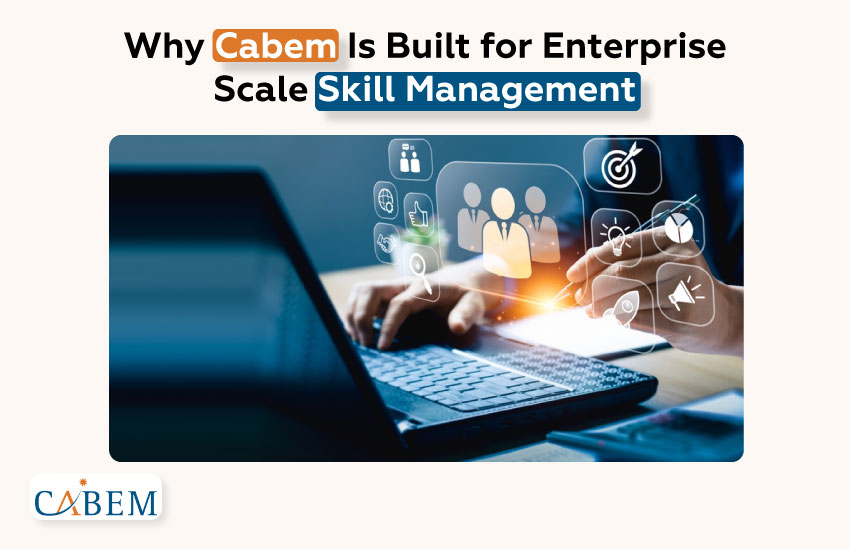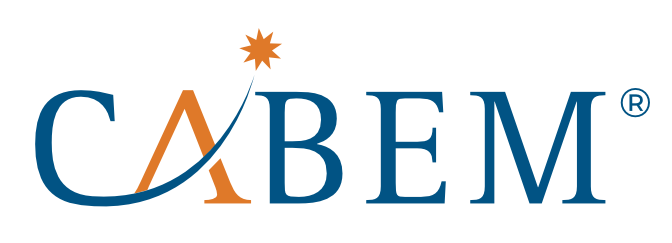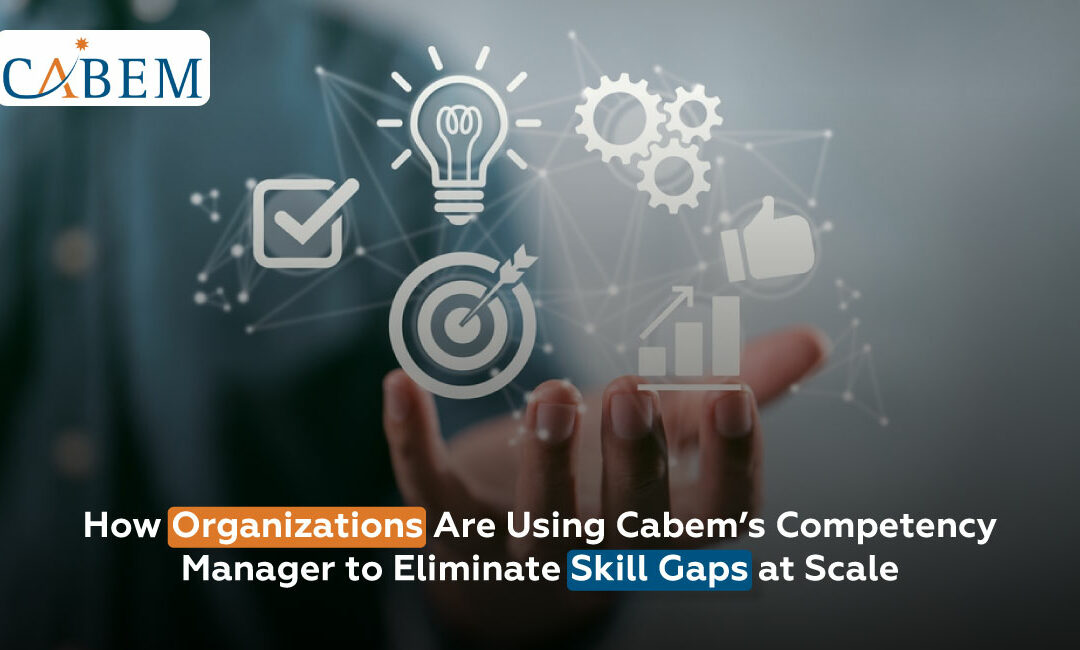Skill gaps are an invisible challenge that may exist in many organizations and are likely to affect performance. Be it due to technological advancements, evolving job roles, or altering team structures, these gaps tend to prevent businesses from achieving their maximum potential. Luckily, solutions like CABEM’s Competency Manager are providing organizations with the scalable means to fill these gaps, increasing employee performance, satisfaction, and ultimately, organizational success.
Did you know that 60% of employees report not getting the training they need to do their best work? Indeed, this is a staggering statistic that underscores the need to face skill gaps as they arise.
But don’t worry, skill gaps can be avoided by delaying organizational processes by deploying the correct tools and processes. In this article, we will discuss the uses of CABEM’s Competency Manager by organizations to bridge skills gaps, the advantages of this process, and how the outcome leads to organizations working more smoothly and efficiently.
The right choice makes all the difference in your organization. In our blog, “How to Choose the Right Competency Manager for Your Organization,” we outline core considerations, from scalability to integration, to help you make the right decision for your needs.

How Skill Gaps Are the Silent Productivity Killers
One of the biggest yet most overlooked productivity killers in any organization is skills gaps. These gaps may not necessarily be apparent on the surface but can stifle growth, morale, and efficiency, which drives a downward trend in overall performance.
Here’s how organizations are impacted by skill gaps.
- Lack of Real-Time Visibility Into Who’s Competent
- Role Mismatch: Certification ≠ Capability
- Inconsistent or Incomplete Training Records
- One-Size-Fits-All Training That Wastes Resources
1. Lack of Real-Time Visibility Into Who’s Competent
Many organizations struggle to find out who possesses which skill sets. The absence of real-time visibility results in inefficient task allocation, ineffective communication, and misalignment between teams.
As per a 2023 Deloitte report, 42% of organizations find it challenging to keep tracking the exact competencies of their staff, leading to delays in the delegation of responsibilities and impacting overall performance.
- Misallocated Tasks: When there is no visibility over employees’ real skills, the work could be handed over to the wrong person, resulting in deadlines being missed or work of inferior quality.
- Team Dynamics: Employee miscommunication or misunderstandings occur because employees may not know the strengths or weaknesses of others.
- Decision-Making: Managers are not able to make decisions on work assignments and promotion schedules due to a lack of information, hindering business growth.
Fact: According to Gallup’s 2022 report, 33% of employees say they feel disengaged because of a lack of clarity in their roles and responsibilities, which is frequently attributed to not having the right skills for the job (Gallup, 2022)
2. Role Mismatch: Certification ≠ Capability
Some companies fall into the trap of thinking that if an employee has a certification, they possess the required skills to do their job efficiently. However, certifications alone don’t guarantee competency.
- Underperformance: Employees may have the certifications, but are underqualified in the actual field due to hands-on skills.
- Wasted Resources: Organizations spend a lot of time and money on certifications, only to find out that such certifications are mismatched with what the jobs require.
Real-World Example:
A 2022 study by the HR Certification Institute (HRCI) found that despite employees having the required certifications, 63% of HR leaders indicated there are skill mismatches in their teams. This lack of alignment led to suboptimal employee performance and resource spending.
3. Inconsistent or Incomplete Training Records
In the absence of a centralized competency management system, this training can often lead to inconsistent or incomplete records of employees’ training progress. The absence of transparency results in:
- Compliance Gaps: Organizations may not comply with regulatory needs to deliver training, which could lead to fines or difficulty in audits.
- Missed Learning Opportunities: With no proper record to track staff training, employees might not get the training required to cover identified skill gaps, resulting in untapped potential.
Fact: 30% of organizations highlighted that management of compliance training in manual format exposes them to non-compliance risk with record inconsistency, according to Capterra’s 2023 LMS Survey.
4. One-Size-Fits-All Training That Wastes Resources
One-size-fits-all, generic training programs are a huge waste of time and money. Not all employees require the same training, and without this targeted approach, organizations are failing to maximize the return on their training investments.
- Wasted Time and Money: Employees who already have some skills may undergo unnecessary training, wasting vital time and money better used elsewhere.
- Failure to Address Specific Gaps: Generic training does not consider individual performance gaps and specific job needs, which leads to leaving some important areas of employee development unaddressed.
Statistic: According to a LinkedIn Learning report in 2022,58% of employees reported that they did not believe their training was aligned with their current role and responsibilities, leading to wasted resources and disengagement.
Organizations can overcome these challenges by implementing CABEM’s Competency Manager taking charge of their skills management and increasing productivity.
What Is CABEM’s Competency Manager?
CABEM’s Competency Manager is a comprehensive utility that enables organizations to manage and nurture their talent pool efficiently. Its extensive features help organizations have full visibility into their employees’ skills on a real-time basis and what can be done to fill the skills gap. CABEM’s Competency Manager is unique in the following ways:
- Build role-specific competency frameworks: Develop competency models tailored for each role in your organization. These are role-based frameworks designed so that employees develop the exact skills they need to succeed in their roles.
- Conduct skill gap assessments and visual dashboards: Identify the skill gaps with the help of automated assessments and easily track the data with visual dashboards. This information enables organizations to target specific training and development initiatives.
- Assign targeted training, mentors, or follow-ups: Based on the skill gap assessments, assign specific training programs, mentorship, or follow-up activities to ensure employees can close the gaps effectively.
- Automate reminders for certifications and evaluations: Keep track of certifications and performance evaluations with automated reminders to ensure their skills are up-to-date and comply with industry regulations.
- Generate audit-ready compliance reports instantly: At the click of a button, generate audit-ready reports in real-time for staff competencies, upskilling status, and certifications. This functionality helps to keep in avoidance of penalties by being regulatory compliant.
CABEM’s Competency Manager offers organizations the ability to streamline their competency management processes with a proactive approach to fill skill gaps. Now, let us discover the advantages of scaling up skill gaps with this powerful tool.

5 Benefits of Eliminating Skill Gaps at Scale with CABEM
Closing those skills gaps is essential for the health and success of any organization. Skill gaps — whether they are hard or soft skills — can greatly affect productivity, safety, quality, and overall employee satisfaction. But with CABEM’s Competency Manager, your organization can bridge skill gaps at scale for a more efficient and empowered workforce.
- Boosts Productivity
- Strengthens Compliance
- Saves Money
- Supports Retention
- Improves Safety & Quality
1.Boosts Productivity
Employees with the right skills and training get the job done better and quicker. According to a 2023 report by McKinsey, companies that emphasize skill development experience an increase in productivity of 20–25% across teams.
CABEM’s Competency Manager enables companies to uncover skill gaps and effectively bridge those gaps so that employees don’t fall behind in their capability to perform the work at hand, resulting in optimized productivity levels throughout the organization.
How CABEM Helps Boost Productivity:
- Real-Time Skill Tracking: Organizations can have a constant eye on their employees in terms of their current competency levels through real-time visibility, making sure that the employees are well-adjusted to handle their tasks.
- Targeted Training Paths: With identified skill gaps, the system creates customized development plans, recommending relevant training programs for accelerated skill acquisition.
- Continuous Feedback Loop: CABEM allows organizations to see where employees stand and change learning plans according to performance metrics.
Case Study:
In one year, Motorola Solutions experienced an 18% increase in team productivity through competency-based training. These numbers highlight how implementing a holistic competency management tool enabled the workforce to handle its skills and align them with what suited the organizational objectives, resulting in better alignment across teams and paving the way for improved overall performance.
2. Strengthens Compliance
In regulated industries (like healthcare, manufacturing, or energy), organizations must keep up with training and certification to remain compliant. CABEM’s Competency Manager automates and organizes the certification management process to ensure every employee meets the standards and regulations necessary, helping to minimize compliance failure risk.
How CABEM Strengthens Compliance:
- Automated Certification Tracking: CABEM’s Competency Manager tracks the expiration dates of certifications and training, ensuring compliance without the need for manual tracking.
- Role-Based Competency Models: The system assigns competencies based on the requirements of the role, ensuring employees are qualified for their positions and minimizing human error.
- Audit-Ready Reporting: With CABEM, you can create real-time, audit-ready reports, which makes compliance reporting easy and reduces administrative effort.
Real-World Impact:
The Deloitte 2024 Compliance Report states that 85% of companies focus more on automating compliance management solutions because of the increasing complexity faced and penalties related to non-compliance.
For instance, Competency manager significantly helped companies such as MedStar St. Mary’s Hospital, making pharmacy certification processes more efficient, and enabling healthcare teams to meet regulatory requirements without effort and time wasted.
3. Saves Money
Competency management investments ensure the effective allocation of training and hiring resources while aligning companies toward the same goals. It saves organizations money and mistakes that can be caused by skills mismatch and ensures that employees are always on an upward curve.
How CABEM Saves Money:
- Reduces External Hiring Costs: Organizations can train existing employees instead of hiring new talent and save on expenses like recruitment, onboarding, and training.
- Decreases Operational Inefficiencies: CABEM mitigates operational costs by assuring employee competency, leading to fewer errors, and resulting in reduced rework.
- Improved Resource Allocation: With CABEM’s system, organizations can target training at real skill gaps, ensuring that they do not waste resources on unnecessary training.
Statistical Evidence:
According to the American Management Association, organizations waste approximately $30 billion each year on training programs that fail to address employee needs or the skills gap. However, organizations that use CABEM can avoid such inefficiencies by streamlining and targeting training, leading to considerable cost savings.
4. Supports Retention
When an employee believes their skills are being developed and supported, they are more likely to stay with the organization. CABEM’s Competency Manager provides personalized development paths that will encourage and inspire employees to stay with your organization over the long haul.
How CABEM Supports Retention:
- Career Development Pathways: CABEM offers employees clearly defined development paths that clearly outline how to grow and progress through the organization.
- Employee Engagement: According to a Gallup survey, employees are 58% more likely to remain with their current employer when those given regular opportunities for training and career development.
- Personalized Learning Paths: By providing training that is personalized based on each employee’s individual needs, CABEM helps employees develop in areas that matter most to them, improving their satisfaction and engagement levels.
Real-World Case Study:
A real estate firm, equipped with Competency Manager, Nesnah Ventures, created personalized development paths for employees that helped retain and increase employee satisfaction. Within the first year of implementing the system, the company reports increased employee retention by 30%.
5. Improves Safety & Quality
In industries where safety is vital, having the right competencies among employees is a top priority. With CABEM’s Competency Manager, businesses can monitor and maintain all records of safety certifications, reducing the risk of accidents and improving overall quality standards.
How CABEM Improves Safety & Quality:
- Competency Tracking for Safety: CABEM enables organizations to track relevant safety qualifications and certifications, guaranteeing safety compliance for employees who operate in hazardous environments.
- Reduces Risk of Accidents: Employees who are trained incorrectly are more prone to making mistakes that can cause accidents. However, CABEM provides proper training to decrease the chance of accidents and thus improve workplace safety.
- Ensures Consistent Quality Standards: Comprehensive competency models help businesses ensure that quality levels are maintained throughout operations with the right skills.
Statistical Evidence:
According to NSC research, states that implemented competency and training solutions saw a reduction of up to 40 percent in workplace accidents. By using CABEM’s Competency Manager, you can ensure that every employee is always current on the certifications they need, which in turn reduces safety risks and enhances operational quality.
Note: Want to boost your organization’s performance to new heights? Learn more about why a Competency Management System is crucial for success in 2025. For example, in our article, “Competency Management System: Why Your Company Needs One.”

Why CABEM Is Built for Enterprise-Scale Skill Management
As organizations go through growth and scaling phases, the intricacy of administering competencies and skills development increases. CABEM’s Competency Manager seeks to address the challenges faced by large organizations with intricate designs, several locations, and diverse employee requirements.
Here’s how it’s made for enterprise-scale skill management:
- Multi-site support: CABEM’s Competency Manager is ideal for organizations with employees across multiple locations, as it allows businesses to manage competencies and training across different sites seamlessly.
- API integrations (HR, LMS, etc.): CABEM’s Competency Manager is a great and effective option for organizations with employees spread across multiple sites. It makes it easy for businesses to manage competencies and training across multiple sites with a single click.
- Role cloning for faster implementation: The platform is easily integrated with other HR systems and Learning Management Systems (LMS), so competency management is part of wider talent management strategies.
- Cross-departmental tracking for compliance teams: Instead of implementing competency frameworks for each role, companies can perform role cloning that significantly reduces the amount of time spent building and assigning competency frameworks related to similar roles across the organization.
CABEM’s Competency Manager is an affordable, scalable, and customizable solution for large organizations to manage skill, competency development, and tracking seamlessly.

Let’s Eliminate Skill Gaps Before They Become Business Gaps with CABEM
As gaps in competencies can swiftly turn into gaps in important business areas, inhibiting growth, productivity, and profitability. The future of work depends on how quickly these gaps can be addressed, and with CABEM’s Competency Manager, organizations can stay ahead of the curve and ensure their workforce has the skills to thrive in a competitive marketplace.
Skill gaps shouldn’t make your organization feel weighed down. CABEM Competency Manager can help you simplify the management of your competencies, resulting in better regulatory compliance, more productivity, and a motivated workforce. Since the future is already here, it is time to act – time to fill skill gaps before they develop into business gaps.
Are you excited to bridge the skill gaps in your organization? Schedule a demo of CABEM’s Competency Manager and see how our solution can help you scale efficiently while closing gaps in skills across your workforce.
FAQs
How can organizations identify gaps in employee knowledge and skills?
Are you excited to bridge the skill gaps in your organization? Schedule a demo of CABEM’s Competency Manager and see how our solution can help you scale efficiently while closing gaps in skills across your workforce.
What methods can employers use to fill skill gaps?
Employers can go a long way to fill skill gaps with targeted training and mentorship programs, opportunities to work in cross-departments, and access to constant educational resources and certification programs.
How to reduce the employability skills gap?
Training employees on both technical and soft skills, including communication, critical thinking, problem-solving, and teamwork, can help bridge the employability skills gaps identified by organizations.
What is an example of a competency gap?
A competency gap might be when an employee holds a certificate for a technical skill but hasn’t encountered the real work challenges associated with using that skill or the critical thinking needed to leverage such skills in the work environment.

